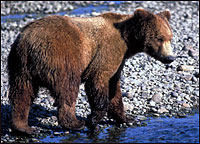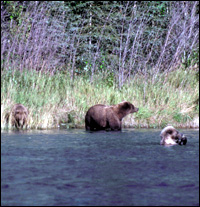



|
Brown Bear - Ursus Arctos Backcountry Safaris Bear Viewing Adventures Basic Facts  The most important item to clarify is that a brown bear and a grizzly bear are the same animal, Ursus arctos. There is a tendency to refer to the bear that lives in the interior as a "grizzly" and its coastal inhabitant as a "brown bear". The difference is mainly a result of food availability. Coastal bears have greater access to rich supplies of protein obtained through feeding on salmon. Bears in the interior have a diet that lacks this protein so their coat tends to be lighter in color and they tend to be smaller. Brown bears on Kodiak Island are classified as a distinct subspecies, Ursus arctos middendorffi, from those on the mainland because they are genetically and physically isolated. The most important item to clarify is that a brown bear and a grizzly bear are the same animal, Ursus arctos. There is a tendency to refer to the bear that lives in the interior as a "grizzly" and its coastal inhabitant as a "brown bear". The difference is mainly a result of food availability. Coastal bears have greater access to rich supplies of protein obtained through feeding on salmon. Bears in the interior have a diet that lacks this protein so their coat tends to be lighter in color and they tend to be smaller. Brown bears on Kodiak Island are classified as a distinct subspecies, Ursus arctos middendorffi, from those on the mainland because they are genetically and physically isolated.In contrast to the black bear, brown bears have a shoulder hump and a "dish-shaped" or concave face. Brown bears are fast for their size, able to attain speeds of 35 miles per hour for a short distance. They have an especially good sense of smell and under the right conditions may be able to detect odors more than a mile away. Their hearing and eyesight are equivalent to that of humans. They may live to 34 years in the wild, though this is rare, generally males live to 22, females 26. Bears are lean in the spring or early summer when they emerge from hibernation. In contrast, they gain weight rapidly during late summer and fall and are very large just prior to denning. Stores of fat will bring a male's weight to between 500 and 900 pounds, while a weight of 1,400 pounds is not unheard of in the fall. Females weigh about 250 to 600 pounds in the fall. Adult brown bears stand approximately 3.5 feet tall when on all fours, and have a body length of just over seven feet. Habitat, Range and Local Sightings  Brown bears occur throughout Alaska, except on the islands south of Frederick Sound in southeastern Alaska, the islands west of Unimak in the Aleutian Chain, and the islands of the Bering Sea. The population on the Kenai Peninsula is estimated at 250-300 bears. Brown bears occur throughout Alaska, except on the islands south of Frederick Sound in southeastern Alaska, the islands west of Unimak in the Aleutian Chain, and the islands of the Bering Sea. The population on the Kenai Peninsula is estimated at 250-300 bears.An animal conducts its normal activities in its home range: gathering food, mating and caring for its young. The size of the home range is extremely dynamic and varies from one geographic region to another, and also from year to year. The size of the home range of an individual brown bear will vary with the concentration of highenergy food sources. The more concentrated the food sources, the smaller the range necessary to maintain the animal. For example, adult male brown bears living in the Brooks Range have an average home range of approximately 521 square miles. Brown bears living in salmon-rich coastal areas, on the other hand, require only about 10.5 square miles. Brown bears do not normally defend their home ranges from other bears, so it is normal for the home ranges of individual bears to overlap each other. In Kenai Fjords, brown bears have been seen around Exit Glacier during the spring (May) and fall, even though this is predominantly a black bear habitat. There have also been observations of brown bears in Nuka Bay, around Pederson Glacier, and in Northwestern Fjord. Food and Survival Strategies  Brown bears are opportunistic feeders, fond of any carrion and often found eating garbage in human dumps. Typically they eat more than 75 percent vegetable matter consisting of berries, flowers, grasses, herbs, and roots. The remaining 25 percent consists of decaying carcasses, fish, insects, elk and moose calves, and a variety of other small mammals. Due to their large size, brown bears require a very high caloric intake of food. In order to achieve this, brown bears will eat 80 to 90 pounds of food per day in the summer and early fall. During this eating binge, in preparation for hibernation, brown bears are able to gain three to six pounds of fat each day. Hibernation lasts from five to eight months in the coldest parts of the brown bear’s range. However, in warmer areas, like Kodiak Island, some bears may remain active throughout the winter season. Brown bears are opportunistic feeders, fond of any carrion and often found eating garbage in human dumps. Typically they eat more than 75 percent vegetable matter consisting of berries, flowers, grasses, herbs, and roots. The remaining 25 percent consists of decaying carcasses, fish, insects, elk and moose calves, and a variety of other small mammals. Due to their large size, brown bears require a very high caloric intake of food. In order to achieve this, brown bears will eat 80 to 90 pounds of food per day in the summer and early fall. During this eating binge, in preparation for hibernation, brown bears are able to gain three to six pounds of fat each day. Hibernation lasts from five to eight months in the coldest parts of the brown bear’s range. However, in warmer areas, like Kodiak Island, some bears may remain active throughout the winter season.Reproduction and Young Female brown bears normally become sexually mature at five or six years of age, their average litter is two cubs and the interval between litters is three to four years. Mating occurs between late May and early July. Females are capable of delayed implantation. If a female does not have enough fat reserves for the winter the embryo will not implant and simply be reabsorbed. Sometime around the denning period, the embryo will attach itself to the uterine wall and after a period of eight weeks (January or February), the cubs will be born while the mother is still in hibernation. At birth, the cubs are blind and hairless, and very tiny—weighing less than a pound. They are able to move sufficiently to suckle on their mother who remains asleep. Her milk is very rich (over 20 percent fat), allowing the cubs to gain weight quickly in preparation to leave the den in April or May. Human Connections  Alaska is home to over 98 percent of the United States population of brown bears, and more than 70 percent of the entire North American population. Bear hunting is popular in Alaska and, with proper management, can occur without causing populations to decline. Bear hunting seasons are held in both spring and fall in some areas, but only in fall in other areas. Cubs and females with offspring may not be killed. Alaska is home to over 98 percent of the United States population of brown bears, and more than 70 percent of the entire North American population. Bear hunting is popular in Alaska and, with proper management, can occur without causing populations to decline. Bear hunting seasons are held in both spring and fall in some areas, but only in fall in other areas. Cubs and females with offspring may not be killed.In the mid-1980s, Alaska Department of Fish and Game, United States Fish and Wildlife Service, the Forest Service, and National Park Service established an Interagency Brown Bear Study Team (IBBST) to monitor and research brown bears on the Kenai Peninsula in order to assess population and long-term cumulative effects on habitat from continued development. In November 1998, Alaska Department of Fish and Game announced the designation of the Kenai brown bear population as an Alaska Species of Special Concern. More general information on Kenai Fjords National Park is available at: Kenai Fjords National Park We would like to thank the NPS for the above information. |




 Did You Know?
Did You Know?